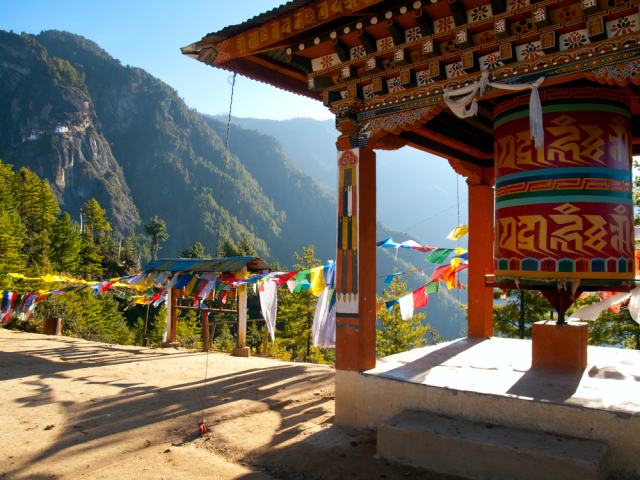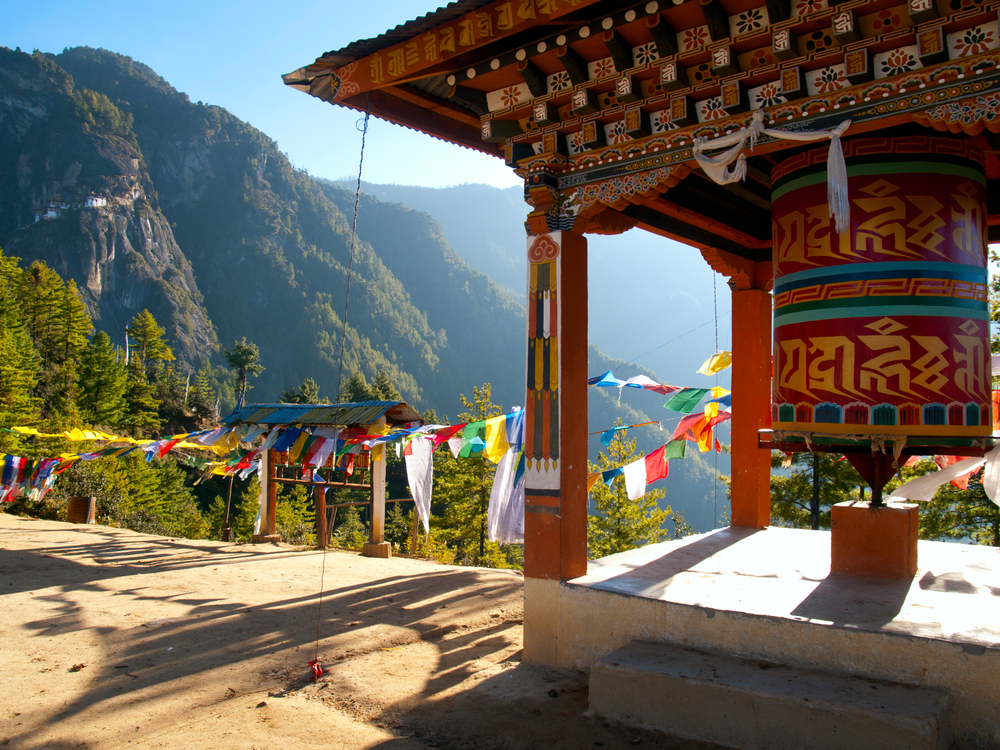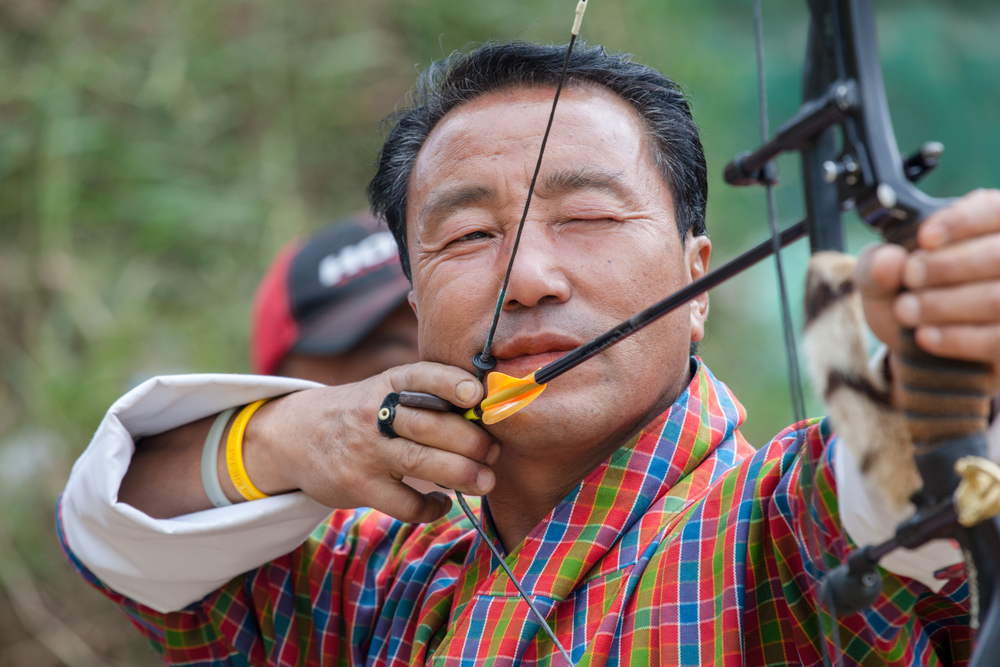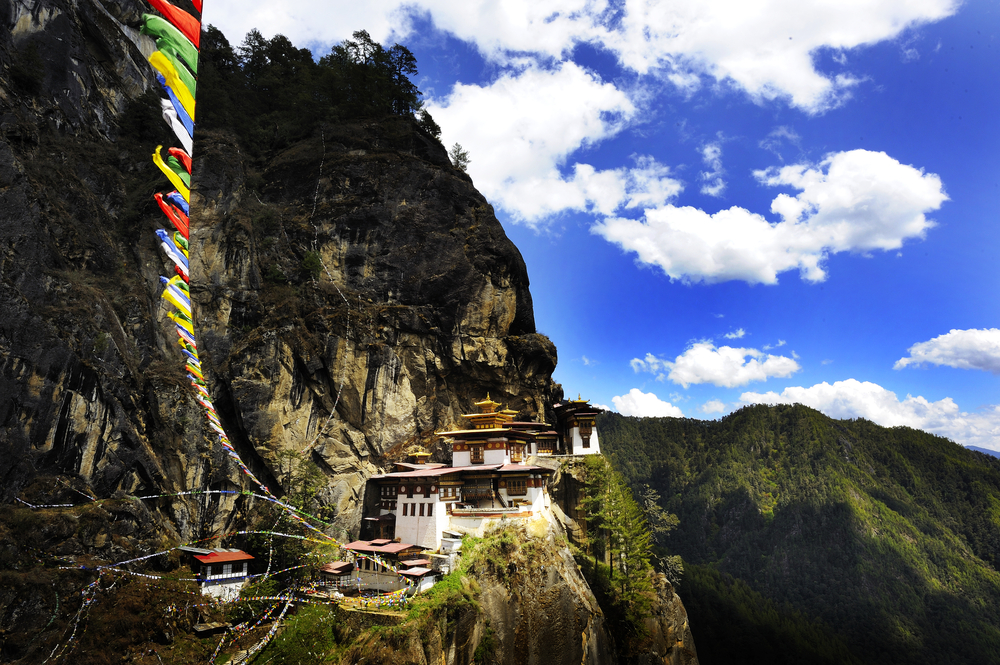Taktshang Monastery via Shutterstock
By Diana Smith
The Kingdom of Bhutan is just larger than the state of Massachusetts. Clenched within the jaws of the Himalayas, between China and India, travel into the tiny country wasn’t possible until the early 1970s when it became a part of the United Nations. Hotels and roads have been built, but in moderation. Satellite TV officially arrived in 1999. A traffic light was briefly installed in the capital city. (It was then uninstalled after complaints about the structure’s impersonal nature and replaced by a traffic officer.) It’s a peaceful country that marches at its own pace and to its own beat, sparking curiosity and intrigue, and a slight challenge as traveling to Bhutan does not come easily or inexpensively. All tourists must make trip arrangements through a Bhutanese travel company at a price of $200-$250 a day. The all-inclusive daily price may seem steep, but we have a few reasons why you should keep it on your bucket list.
1. NATIONAL HAPPINESS
Or Gross National Happiness (GNH) to be exact, and it’s the way that Bhutan measures its prosperity. While it is common in most of the world to measure a country’s progress in terms of the Gross Domestic Product, or material goods and development, Bhutan wanted to build an economy that strived to serve its Buddhist values, placing a priority on the quality of life, or the happiness, of its people. To do so, a dedicated GNH committee ensures that all policies and resource allocations meet core principles, such as sustainable development, spiritual and cultural preservation, environmental conservation, and good governance.
2. MOTHER EARTH MATTERS
Preservation of the environment and ecosystems is so important that it’s written into the constitution that 60 percent of Bhutan’s land must remain forested. Currently, 72 percent of Bhutan is forested and national parks, wildlife sanctuaries, and nature preserves make up about 26 percent. Bhutan is also the only country in the world that absorbs more CO2 than it produces and is the only country with hydroelectricity as its largest export. Plastic bags have also been banned since 1999.
3. TOBACCO FREE
Since 1729, when Bhutan became the first country in the world to place restrictions on tobacco, it has been making history with its progressive stance on the product. In 2005, the sale of tobacco products was strictly prohibited, and anyone who wishes to light up must acquire a license so that they can smoke in designated areas. Even then, smoking is highly frowned upon. Discretion is advised.
4. WEED GROWS LIKE A WEED
Despite the Bhutanese’s stance on smoking, the country’s climate is perfect for marijuana. Ironically, cannabis grows legally all over the kingdom. But smoking it, of course, is outlawed and, instead, is used as pig food. Even so, if you’ve every been curious about what fields and fields of wild marijuana look like then Bhutan certainly satisfies that sight. Then again, if you’re not a strict non-smoker, the sight could just be pure torture.
5. ARCHERY FACEOFFS
Bhutanese Archer via Shutterstock
Firing at a lone target was just too simple for the Bhutanese. Here, their national sport is taken to a whole new level when teams not only launch arrows at their targets but also each other. Two teams stand at opposite ends of a range and gather near the opposing team’s target with the hopes of distracting the other team from hitting the bullseye. (Never mind the steel-tipped arrows being hurled towards them; hospitals in Bhutan are more than familiar with how to treat archery injuries.) The teams and the targets—pieces of wood that are three feet high and just under a foot wide—are approximately 140 meters apart, which is twice the distance of the targets at the Olympics and well over the length of a football field. The traditional colorful robes along with the dancing and celebrating that happens for each target hit, makes the competition a little less like “The Hunger Games” and a lot more fun.
6. FIERY FOOD
Rice may be consumed three times a day, but chilies are a Bhutanese favorite and they give most dishes a real kick. The spice may be hard for some to handle, but chefs will often lower the heat for foreigners.
7. LUCKY PHALLUSES
There is no mistaking what is decorating people’s homes or what is painted on the sides of buildings. Phallic worship is often linked to the 15th-century Buddhist teacher Drukpa Kunley, who believed that there were evil demonesses that could only be subdued with his “thunderbolt.” To this day, phalluses are a symbol of good luck and are believed to aid in fertility, offer protection from evil spirits, and drive away malicious gossip.
8. THE VIEW
Bhutan Tiger Nest via Shutterstock
Did we mention that Bhutan is in the Himalayan Mountains? Don’t worry, if you missed the view of Everest on the plane ride in, you’ll still have incredible vistas the rest of your trip.
 About the Writer
About the Writer
Diana Smith is a Brooklyn-based writer and photographer originally from the San Francisco Bay Area. In addition to her travels in Europe, she has also explored the US, adventuring from coast to coast and back again by way of the road. When Diana isn’t road-tripping she volunteers with a non-profit AIDS organization in New York City. Diana holds a BA in film and media studies from the University of California-Irvine and an MFA in creative writing from Emerson College. To view more excerpts from her travels visit RoadsAmerica.com or find her on Twitter @Roads_America.
Feature photo of Taktshang Monastery via Shutterstock.






